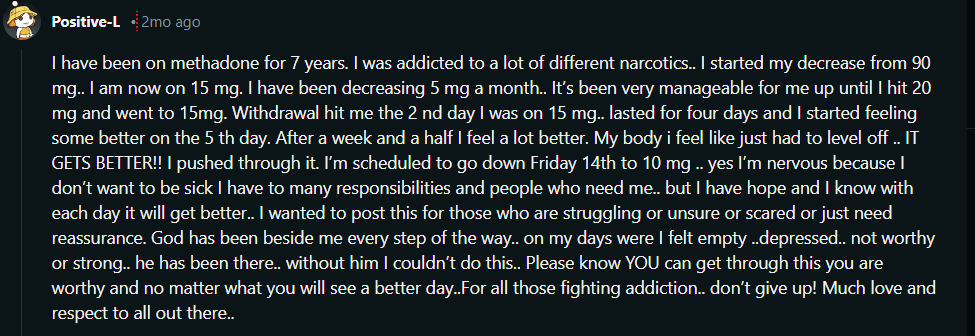Methadone is a long-acting opioid often used to treat pain and manage opioid use disorders (OUDs). If you're struggling with methadone addiction, Orange County Drug & Alcohol Rehab Center offers one of the best methadone detox treatment in Orange County, CA. We treat diverse conditions and guide patients on their journey to sobriety. Understanding methadone detox treatment is crucial for those looking to safely manage withdrawal and reclaim their lives.

The process of detoxing from methadone can be challenging, with symptoms like nausea, vomiting, sweating, and insomnia. These symptoms can make it difficult to stop using methadone without proper medical support. According to the Canadian Addiction Treatment Centres (CATC), traditional detoxification and drug-free techniques have a success rate of only 5% to 10%, whereas methadone treatment programs have a success rate of 60% to 90%. A well-structured medical detox program can provide the necessary care and planning to ease these symptoms and support the individual's journey to recovery.
In a medical detox program, a dedicated team of healthcare professionals, including doctors and nurses, closely monitors the patient around the clock. This team can help manage withdrawal symptoms and reduce cravings, making the process more manageable. The CATC also notes that the benefits of methadone treatment can be achieved if a patient stays in the program for 42 to 90 days, depending on their state of dependence and abuse. By entering a comprehensive detox program, individuals can increase their chances of successful recovery and long-term sobriety.

This Redditor shared how methadone treatment has positively transformed their life after years of narcotic addiction. They successfully reduced their dosage from 90 mg to 15 mg, finding the process manageable and gaining a sense of accomplishment as they progressed. Despite experiencing some withdrawal symptoms, they expressed hope and determination to continue, emphasizing that the treatment has given them the stability to fulfill their responsibilities and support those who rely on them.
Through the structured support of a methadone detox program, individuals can experience significant improvements in their quality of life. This treatment not only alleviates withdrawal symptoms but also helps patients regain control over their lives, enabling them to meet personal and professional responsibilities. With proper guidance and medical supervision, methadone treatment offers a path to sustainable recovery and renewed hope for those overcoming opioid addiction.
Why is Orange County CA a Great Place for Methadone Detox?
Orange County, California, offers an ideal environment for methadone detox. It combines beautiful landscapes and high-quality care, making recovery a positive experience.
One of the main attractions is the availability of luxury detox centers, including Orange County Drug & Alcohol Rehab Center. These facilities provide a serene setting. They are partnered with top-tier amenities such as fitness centers, yoga, and meditation. Patients receive 24-hour monitoring and supervision by trained and experienced medical staff. This ensures they're safe and supported throughout their detox process.

Orange County also benefits from a sunny, mild climate. The pleasant weather supports outdoor activities. This can be beneficial for physical and mental health during recovery. There are multiple detox centers to choose from, each with unique programs. From outpatient options to more intensive inpatient care, individuals can find what suits their needs best.
Additionally, the community around Orange County is known for its strong support networks. They also have numerous recovery groups. These resources help individuals stay committed to their recovery journey. The care, facilities, and environment makes Orange County great for methadone detox.
What Does Detox Mean?
Detox, short for detoxification, is the process of removing toxic substances from the body. This is a crucial step for individuals who have been using drugs like methadone. It helps to clear the drug out of the system. It also addresses withdrawal symptoms, which can vary in severity. Common symptoms include flu-like feelings, vomiting, diarrhea, sweating, and insomnia.
During detox, medical professionals often provide 24/7 care. This helps manage withdrawal symptoms and ensures the safety of the individual. They may use medications to ease the process and address symptoms.
Methadone Detox
Methadone is an opioid used to treat pain or opioid use disorder. Because it is long-acting, methadone stays in the body longer than other opioids. As a result, withdrawal symptoms may start about 30 hours after the last dose and can last for two to three weeks.
Safe Detox Practices:
- Medical Supervision: Ensures safety and manages symptoms.
- Supportive Care: Includes counseling and therapy.
- Medication: May be used to ease withdrawal.
Effective detox is the first step toward recovery. By removing the drug from the body and managing withdrawal, individuals can begin the path to a healthier life. Detox alone is not a cure but prepares individuals for further treatment and long-term recovery.
What are the Methadone Detoxification Treatments?
Methadone detox treatments include various methods to help reduce dependency and manage withdrawal symptoms. These methods can be tailored to meet individual needs and circumstances.
Tapering Method
The tapering method is the most common methadone detoxification treatment. It involves gradually reducing the dose of methadone over time. This method helps the body adjust slowly, minimizing withdrawal symptoms. It requires careful planning and monitoring by medical professionals.
A doctor will create a schedule that decreases the methadone dosage at regular intervals. This approach is one of the safest and most effective ways to manage detox. Regular check-ups are crucial to assess progress and make any necessary adjustments to the plan.
Buprenorphine-Assisted Detox
Buprenorphine is another medication used in detox treatments. It's a partial opioid agonist, meaning it produces less intense effects than methadone or other opioids. This makes it a useful tool for managing withdrawal symptoms.
Treatment involves replacing methadone with buprenorphine in a controlled manner. This switch can help reduce cravings and ease withdrawal symptoms. Medical professionals often choose this method for its effectiveness in providing relief without producing the full effects of stronger opioids.
Clonidine-Assisted Detox
Clonidine is a medication that helps manage symptoms of methadone withdrawal, such as anxiety, agitation, and muscle aches. Though not an opioid, it can make the detox process more comfortable.
Clonidine works by affecting the part of the nervous system that controls stress responses. It’s often used in combination with other medications or therapies. It is important for patients to be monitored closely to manage any potential side effects and to adjust dosages as needed.
Outpatient vs. Inpatient Detox
Outpatient and inpatient detox options offer different benefits. Inpatient detox involves staying at a treatment facility where medical professionals provide around-the-clock care. This is ideal for those with severe dependencies or co-occurring health issues.
Outpatient detox allows patients to continue living at home while attending regular treatment sessions. This option can be more flexible and less disruptive to daily life. The choice between inpatient and outpatient detox depends on the individual's specific needs, the severity of their addiction, and personal circumstances.
Real Life Experiences with Methadone Detox in Reddit
Methadone detox is never an easy task. Many people from reddit shared their experiences dealing with methadone. Here’s some of their stories:

This redditor shared their experience of successfully tapering off methadone to treat heroin withdrawal, starting at 10mg and reducing to 2.5mg over ten days. They mentioned still experiencing symptoms like insomnia and diarrhea 20 days after stopping, emphasizing the importance of a slow and steady taper for those on higher doses. They noted that their previous experience with higher doses made quitting more challenging, prompting their decision to use smaller doses over a shorter period this time.

This guy shared his experience of tapering off methadone after six years of maintenance following 17 years of opiate use, expressing relief that withdrawal symptoms like diarrhea and muscle tension were less severe than expected. They advised to stay hydrated with Gatorade and avoid replacing methadone with another addictive substance. They emphasized seeking personal spiritual guidance for support, suggesting that talking to God, like a friend, can provide direction and help in achieving a fulfilling life.
What is the Importance of Emotional and Social Support for Methadone Detox?
Psychosocial support integrates counseling and community resources to help patients manage their detox process. These efforts address emotional, social, and psychological challenges during methadone detox treatment.
Counseling During Detox
Counseling plays a key role in helping patients navigate methadone detox. Individual counseling helps patients explore their personal triggers and develop strategies to avoid relapse. It also allows patients to discuss their feelings and challenges in a safe and confidential environment. Regular sessions with a trained counselor can make the detox process more manageable by providing constant support and guidance.
Group counseling offers a collective support system. In these sessions, patients can share their experiences and receive feedback. This communal support enhances motivation to stick with the detox program. Group dynamics also help foster a sense of belonging and understanding among participants.
Support Groups and Community Resources
Support groups provide a network of encouragement. They are usually facilitated by experienced individuals who have gone through similar experiences. Attending these groups can reduce feelings of isolation and provide practical advice from peers. Community resources further bolster support systems during detox. Resources might include access to specialized programs, job training, and housing assistance. These services help patients rebuild their lives during and after treatment.
Organizations often partner with local resources to create a comprehensive support network. These partnerships aim to address the varied needs that might arise during detox, ensuring patients have access to the necessary tools to succeed.
How Do You Manage Withdrawal Symptoms?
Withdrawal symptoms can be managed through a gradual tapering of methadone under medical supervision, along with supportive care such as counseling, hydration, nutrition, and, when necessary, the use of medications like clonidine or buprenorphine to alleviate symptoms. Access to therapy and support groups can also help address psychological aspects of withdrawal and reduce the risk of relapse. Here’s a more comprehensive overview
Medical Supervision: Withdrawal should occur under medical supervision. Doctors can prescribe medications to ease symptoms.
Medication Options:
- Buprenorphine: Reduces withdrawal symptoms.
- Clonidine: Eases anxiety, sweating, and muscle aches.
- Over-the-counter meds: Help manage pain, nausea, and other symptoms.
Hydration and Nutrition: Staying hydrated and eating nutritious food can support the body during withdrawal. Fluids help replace lost electrolytes, and balanced meals can improve overall well-being.
Rest and Sleep: Adequate rest is crucial. Sleep aids like melatonin might help with insomnia, a common withdrawal symptom.
Therapeutic Support: Talking to a therapist or counselor can address the emotional challenges of withdrawal. Support groups offer shared experiences and encouragement.
Exercise: Light exercise, such as walking or yoga, can relieve stress and improve mood. It may also help reduce physical discomfort.
Environment: A calm and supportive environment is essential. Reduce stressors and ensure a quiet place for rest and recovery.
Monitoring Symptoms: Regularly monitor symptoms and communicate with healthcare providers. This ensures prompt adjustments to the treatment plan if needed.
Hot Baths and Heating Pads: Hot baths and heating pads can soothe muscle aches and pains. They also help the body relax.
Avoiding Triggers: Stay away from situations or places that might trigger cravings. A support network can help reinforce this strategy.
What is Methadone Withdrawal?
Methadone withdrawal happens when someone stops taking methadone, a long-acting opioid used for pain relief and managing opioid use disorders (OUDs). Methadone is typically administered as part of a medically supervised treatment plan to reduce dependence on more harmful opioids, such as heroin or prescription painkillers.
While methadone can be an effective treatment for OUDs, discontinuing its use can lead to withdrawal symptoms. These symptoms can be uncomfortable and may include both physical and psychological effects.

How Do You Prevent Relapse?
Aftercare and relapse prevention are crucial to maintaining sobriety after methadone detox. Effective aftercare includes multiple strategies and support systems to help individuals stay drug-free.
Post-Detox Treatment Options
After methadone detox, several post-detox treatment options can support long-term recovery. One common approach is therapy, which may include individual counseling, group therapy, or cognitive-behavioral therapy (CBT). These therapies address the psychological aspects of addiction and provide coping strategies.
Another vital component is medication-assisted treatment (MAT). Medications like buprenorphine or naltrexone can help manage cravings and reduce the risk of relapse. For many, joining a community support group, such as a 12-Step group or SMART Recovery, offers ongoing peer support and accountability.
Strategies for Long-Term Sobriety
Maintaining sobriety involves specific strategies that can help prevent relapse. Establishing a strong support network is essential. Family members and friends can provide emotional support and encouragement. Creating a relapse prevention plan is another key strategy. This plan might include identifying triggers, learning to manage stress, and setting goals for personal growth.
Continued therapy and regular check-ins with addiction specialists can also help individuals stay on track.
Finding healthy activities and hobbies is crucial for long-term success. Engaging in physical exercise, volunteering, or pursuing a new interest can fill the time previously spent on substance use and contribute to a fulfilling, sober life.
The Experience of Derek Lambert’s Brother with Methadone

Derek shares his brother's decade-long journey with methadone treatment. He started using methadone as a way to manage his addiction to prescription painkillers like Percocet. He did this to avoid withdrawal symptoms. Unaware of methadone's withdrawal effects, he found the medication helped him maintain a sense of normalcy for many years. However, he faced challenges when trying to discontinue its use. He experienced severe withdrawal symptoms that led him back to methadone.
How Derek's Brother Managed His Addiction with Methadone
Derek's brother was on methadone for around ten years and experienced both its benefits and challenges. He admitted to not following the proper tapering procedures, which exacerbated withdrawal symptoms. He would misuse his doses to get high, which led to inconsistent management of his medication. Despite these issues, methadone helped him avoid the withdrawal effects of other opioids. This allowed him to function daily.
How He is Doing Today
Today, Derek’s brother is off methadone and reflects on the freedom and normalcy he feels without having to rely on the medication. He acknowledges the benefits of methadone and suboxone for those who need it. But, he emphasizes the importance of using these treatments correctly under medical supervision. His journey off methadone involved a difficult withdrawal process. Ultimately, he feels better and more productive without the dependency on the drug.
Any questions? Contact us anytime
Contact Us
We will get back to you as soon as possible
Please try again later
MEDICATION ASSISTED TREATMENT
We offer MAT Medication Assistant Treatment, both Maintenance and Anti Craving. Our Technological, Medical and Clinical treatment approach mitigates and heals alcoholism, opiate dependency, benzodiazepine dependency and the underlying causes and conditions.
ABOUT OC REHAB CENTER
Orange County Drug and Alcohol Rehab Center is located at Irvine Blvd Tustin, CA. We have a facility that you will go through when you become admitted to our drug treatment facility. In this part of the country, the weather is beautiful; most of the year it is sunny, and it creates the perfect atmosphere to recover from your alcohol or drug addiction. If you or a loved one are suffering from substance abuse, then learn more about our drug treatment facility to see if we’re the right program for your recovery.
